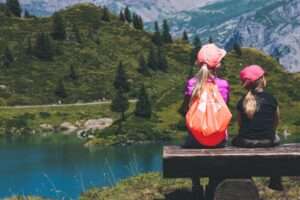Staying Safe while Exploring Nature

Getting out into nature can be a great way to recharge, improve mental wellbeing, and be active. We are lucky, in Seattle, to have so many great places to explore. Urban green spaces like Discovery Park, Seward Park, and Carkeek Park are perfect for an afternoon stroll. And with the Cascades and Olympics surrounding the city, there are miles of trails to explore within an hour or two of downtown. During the summer, Seattle Metro even runs a program called Trailhead Direct, to help public transit users to access hiking areas outside of the city. Spending time in nature can be fun and exhilarating, but it is important to be prepared. To ensure you and your family have the best possible time out there, here are some tips to stay safe and healthy while enjoying the great outdoors.
Get to know the area and your planned route
Before hitting the road, look up for destination and print out a good map that shows you the trails and nearby roads. This is a great way to help your kids practice map skills. Have them plan out your route by highlighting or marking it on the map. Check the park’s website or trail reports before you go to make sure the area is safe and accessible.
Let someone know where you’re going
Before setting off on your hike, check in with someone you trust. Let them know where you are going, your planned route, and your expected start and finish times. Plan to contact them at the end of your outing, so they know you made it home safely. If something happens, and you don’t check in on time, they should be prepared to contact the authorities. If you are going into more remote wilderness areas, it is recommended that you also check in at the ranger station.
Check for closures due to wildfires
While wildfires are a natural part of our ecosystem, they are getting more frequent and larger in Washington for a variety of reasons. Some have even brought smoke into Seattle. Before heading out on a hike, especially in the summer and early fall, be sure to check for closures due to wildfires. Do not enter into a park or on a trail that is closed, even if it appears safe. If a park is open, but the air is smoky or there are fires nearby, it is a good idea to choose a different location.
Keep an eye on the weather
In the Pacific Northwest, the weather can change quickly, turning a warm, sunny morning into a cool and wet afternoon. Be sure to check the weather forecast for your hiking destination and prepare for sudden changes. Layering your clothing is a great way to be prepared for any weather. Don’t forget a waterproof outer layer!
Protect your feet
Flip flops are great for a day at the beach, but if you’re hitting the trails be sure to wear well-fitted, sturdy, and comfortable sneakers, walking shoes, or hiking boots (bonus points if they are waterproof!). If you’re going on a longer hike, it’s also a good idea to bring an extra pair of socks, in case your first pair gets wet.
Protect yourself from bugs and sun
Nothing ruins a day out like bug bites or a bad sunburn. If you will be in a sunny area, protect yourself from harmful rays with UV protective clothing, a hat, and/or sunscreen. You can keep bugs at bay with insect repellant or by wearing protective clothing (long sleeves, long pants, high socks). While ticks are not common in the Seattle area, it’s good to get in the habit of doing a quick tick check after a hike in the woods, especially if your adventures take you to eastern Washington.
Bring water and snacks
It’s easy to get dehydrated when you are outside and being active, especially on warmer days. For shorter hikes, a bottle per person is probably enough, but experts recommend drinking about 16 ounces (or two cups) per hour, and always bringing twice the amount of water you need, in case of emergencies. Don’t forget some nutritious and easy-to-digest snacks, like granola bars or trail mix. Bring extra snacks, in case of emergencies.
Pack a first aid kit
Accidents happen, and small cuts, bumps, and bruises are common when exploring new places. It’s always good to be prepared with at least a basic first aid kit. At minimum, it should include things to cover a wound like adhesive bandages, gauze, sterile pads, and medical tape and things to clean wounds, like antiseptic wipes, as well as anti-itch treatment, pain relievers, antihistamines, and tweezers to remove splinters and stingers. Make sure to also take any personal medications, EpiPens, and/or inhalers for everyone who needs them.
Be prepared for anything
If you are going on a hike outside of the city, it’s a good idea to bring a few extra supplies, in case of emergencies. This includes sources of light, shelter, and fire. “The 10 Essentials” is a great place to start. This list, provided by the National Park Service and others, includes the basic survival items every hiker should have on hand. A great way to get the kids thinking about safety is to create a checklist and have them check off items as you pack them.
Ready to hit the trail? Here are some great family hikes in and around Seattle:
